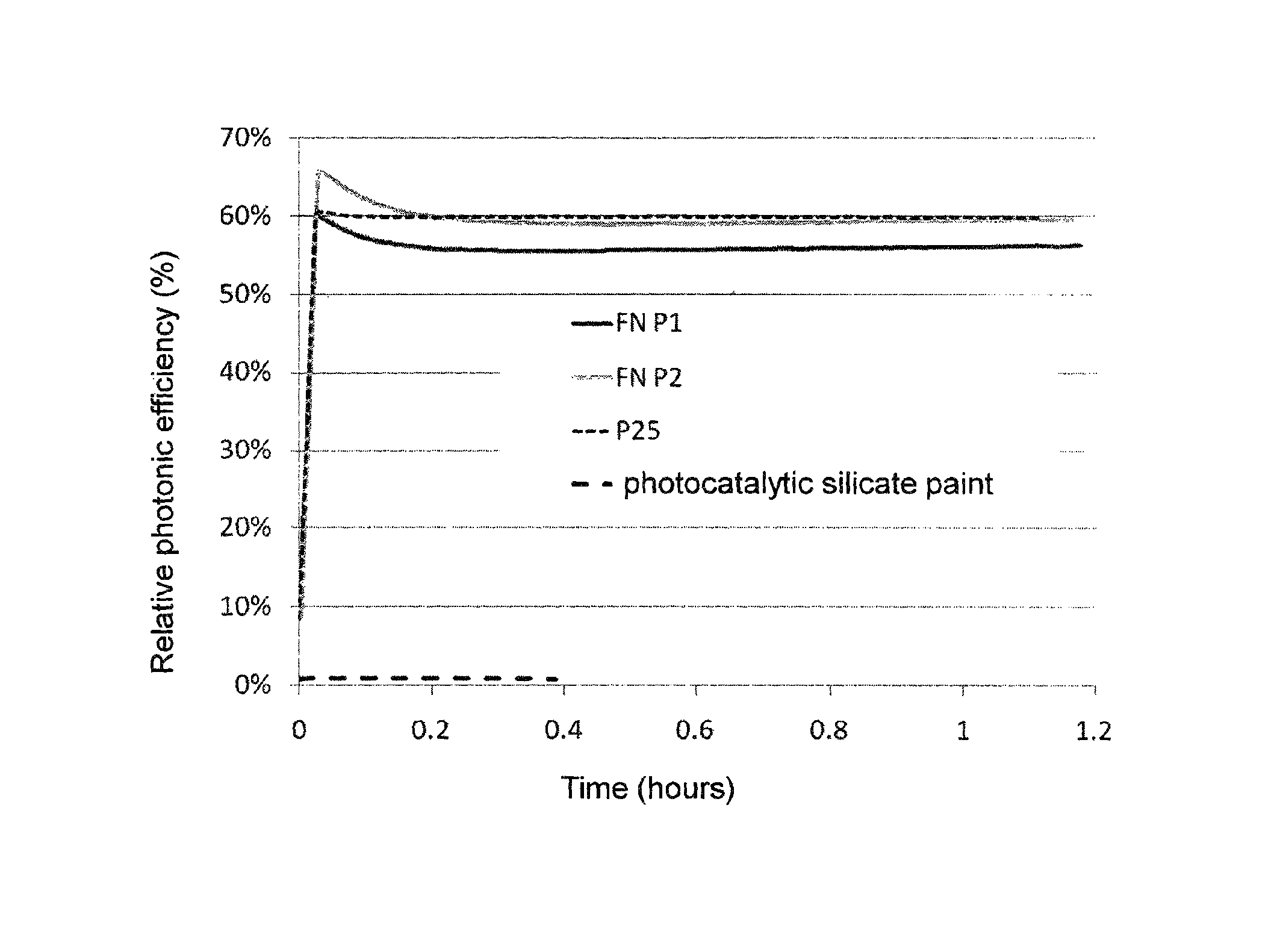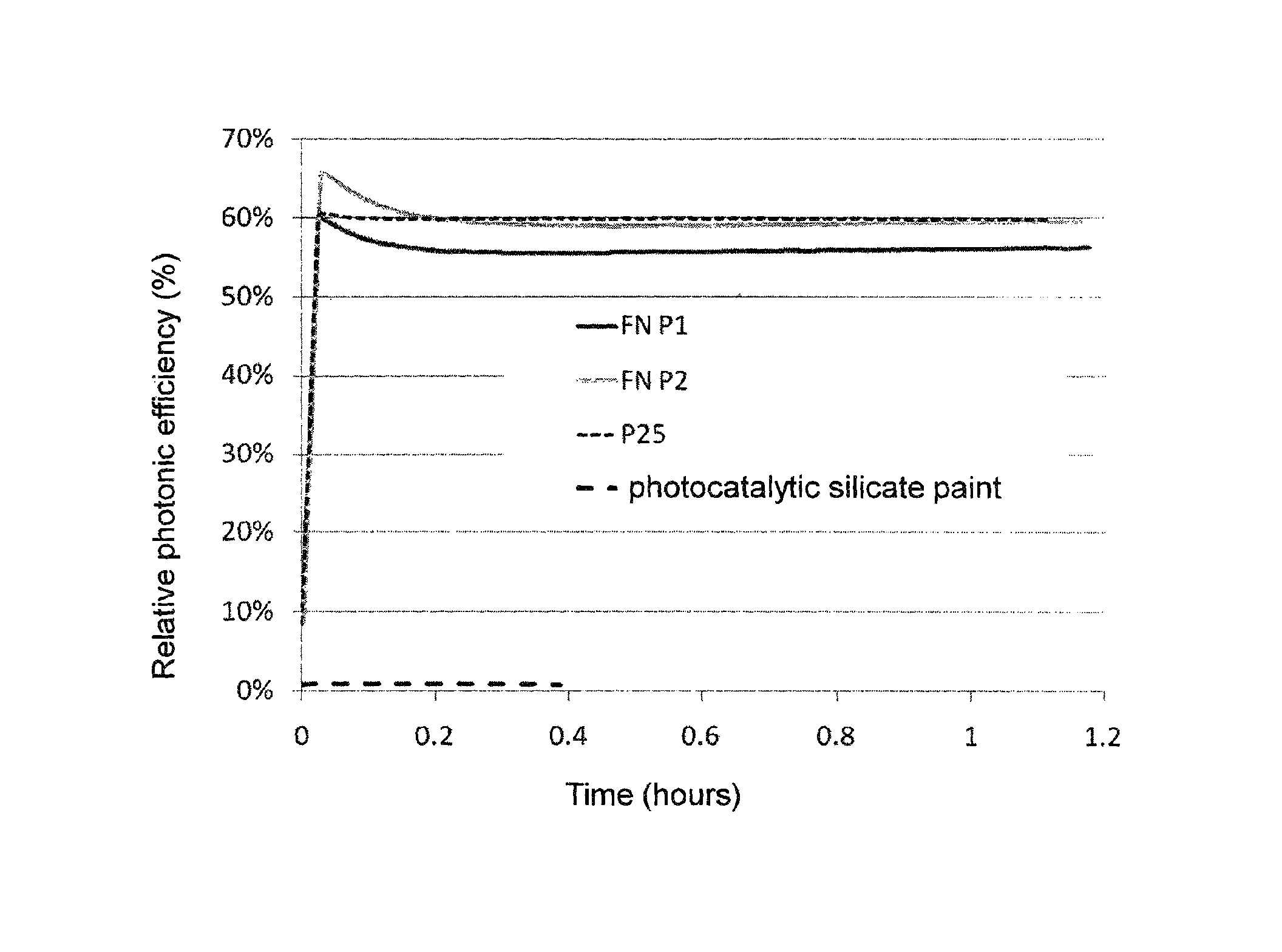Surface treatment agent with high photocatalytic and sanitary effects
a surface treatment agent and photocatalytic technology, applied in the direction of lime coating, physical/chemical process catalyst, metal/metal-oxide/metal-hydroxide catalyst, etc., can solve the problems of blocking the desired photocatalytic effect, decomposing, literally burning the surrounding organic acrylate, etc., to achieve the effect of removing odour
- Summary
- Abstract
- Description
- Claims
- Application Information
AI Technical Summary
Benefits of technology
Problems solved by technology
Method used
Image
Examples
example 1
[0034]TiO2 nanoparticles with specific surface area 50 m2 / g (Degussa P25) were mixed in water in different concentrations, corresponding to 20, 30, 50 and 100 g of TiO2 per liter, and were transformed into suspension by high intensity mixing. Various amounts of saturated solution of Ca(OH)2 were slowly added to these suspensions (see table 1). Concentrated solution of Ca(OH)2 contains a maximum of 2 g Ca(OH)2 / liter, while pH of the solution is very high—14.
[0035]
TABLE 1Binding BindingSubstanceSubstanceActiveAmountBindingAmount Ratio inSubstance(G / l)Substance(G / l)Solids (%)pHTiO220Ca(OH)21.47.0%9.5TiO230Ca(OH)21.44.7%9TiO250Ca(OH)21.42.8%8.5TiO250Ca(OH)212.0%8TiO2100Ca(OH)211.0%6.5TiO230Ca(OH)2 + 1 g ZnO13.3%7TiO250Ca(OH)2 + 1 g ZnO12.0%7
[0036]When solution of Ca(OH)2 was added, the agent was almost immediately getting very thick in all cases. In several cases, the concentration of TiO2 was relatively very low—as low as 20 g / liter. The addition of 1-1.4 g / liter of Ca(OH)2 was also ve...
example 2
[0048]TiO2 nanoparticles were mixed into water in different concentrations and were transformed into suspension by highly intensive mixing. Small amounts of the tested binding ingredients were added to these suspensions and the binding effect of these, often completely inert, substances was monitored. Final concentrations of the suspensions were 20 to 300 g of TiO2 per liter and the addition of binding ingredients typically amounted only 1 to 2 g / liter.
[0049]The list of substances that were subject to testing of their binding effect are in the Table 2. Some of the substances functioned immediately, and similar to the example 1, the suspensions were getting thick instantly after the binding substance was added. These agents are stable, show almost zero sedimentation, neutral pH and are ideal with respect to their very good adhesion to various surfaces. Concentrations of TiO2 in the agents were 20, 30, 50, 100, 200 and 300 g of TiO2 per liter, similar to the preceding example, and the...
example 3
[0056]The agent comprising only the suspension of 100 g of TiO2 / liter was sprayed in two layers on the outside tiling of porous limestone, creating almost transparent film 5 to 10 micrometers thick, with a slightly whitish undertone. Pure sandstone and sandstone treated with sprayed lime water were used as reference surfaces. Both of them were sprayed with the same TiO2 agent. All surfaces were subsequently exposed to the external climate conditions. Layer of TiO2 on pure sandstone was washed away by rain within three weeks while on other surfaces, limestone and sandstone treated with sprayed lime water, it remained almost intact. These surfaces maintain long-term self-cleaning properties.
PUM
| Property | Measurement | Unit |
|---|---|---|
| temperature | aaaaa | aaaaa |
| thickness | aaaaa | aaaaa |
| thickness | aaaaa | aaaaa |
Abstract
Description
Claims
Application Information
 Login to View More
Login to View More - R&D
- Intellectual Property
- Life Sciences
- Materials
- Tech Scout
- Unparalleled Data Quality
- Higher Quality Content
- 60% Fewer Hallucinations
Browse by: Latest US Patents, China's latest patents, Technical Efficacy Thesaurus, Application Domain, Technology Topic, Popular Technical Reports.
© 2025 PatSnap. All rights reserved.Legal|Privacy policy|Modern Slavery Act Transparency Statement|Sitemap|About US| Contact US: help@patsnap.com


